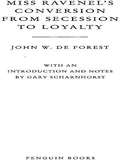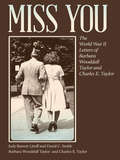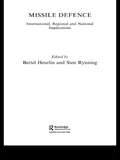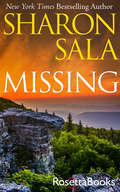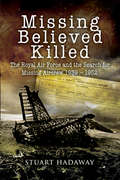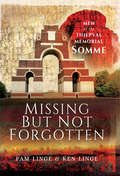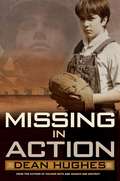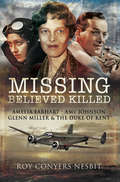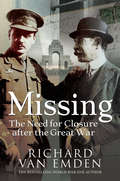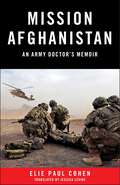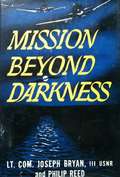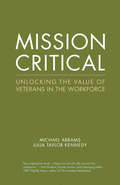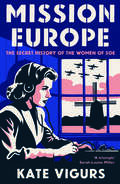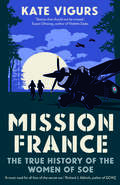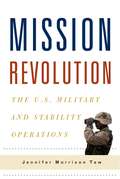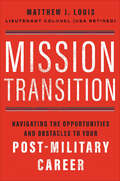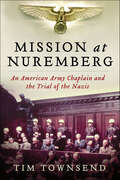- Table View
- List View
Miss Ravenel's Conversion from Secessions to Loyalty
by Gary Scharnhorst John W. De ForestMore panoramic in scope and more realistic in its details than Crane's Red Badge of Courage, this is one of the first and best novels ever written about the American Civil War. Drawing on his own combat experience with the Union forces, John W. De Forest crafted a war novel like nothing before it in the annals of American literature. His first-hand knowledge of "the wilderness of death" made its way on to the pages of his riveting novel with devastating effect. Whether depicting the tedium before combat, the unspoken horror of battle, or the grisly butchery of the field hospital, De Forest broke new ground, anticipating the realistic war writings of Ernest Hemingway, Norman Mailer, and Tim O'Brien. A commercial failure in its own day, De Forest's story was praised by Henry James and William Dean Howells, who, comparing it favorably to War and Peace, acclaimed the book "one of the best American novels ever written." Edited with an Introduction and Notes by Gary Scharnhorst
Miss You: The World War II Letters of Barbara Wooddall Taylor and Charles E. Taylor
by Barbara Wooddall Taylor Charles E. TaylorExperience World War II from the perspective of a married couple in this collection of letters exchanged between an American serviceman and his wife. During World War II, the millions of letters American servicemen exchanged with their wives and sweethearts were a lifeline, a vital way of sustaining morale on both fronts. Intimate and poignant, Miss You offers a rich selection from the correspondence of one such couple, revealing their longings, affection, hopes, and fears and affording a privileged look at how ordinary people lived through the upheavals of the last century&’s greatest conflict.&“In Fairburn, Georgia, when I was growing up, everyone knew them simply as &“CharlieandBarbara,&” one word―for they seemed almost uncannily close, a single unit of harmony, two parts of a whole. Now everyone who reads this extraordinary document of love in a time of war will feel the power of that closeness. Miss You is the quintessential American chronicle…. Read and cherish it―there are none of us who wouldn&’t have chosen for ourselves such a love as this.&”—Anne Rivers Siddons, New York Times–bestselling author of Peachtree Road &“A volume that offers extraordinary insight into the daily experiences of Americans at war.&”—Georgia Historical Quarterly &“Their great love―the connecting theme of this wonderful book―is something so rare it is both beautiful and ennobling.&”—Atlanta Journal-Constitution &“It is the insight gained by reading these letters that make this book exceptional…. By the book&’s close, the reader has gained an intimate and truthful understanding of wartime psyche and feels deeply how crucial these letters were to those they were comforting.&”—Hannah M. Jocelyn, Southern Historian
Missile Defence: International, Regional and National Implications (Contemporary Security Studies)
by Sten Rynning Bertel HeurlinThe missile defence policy of the US plays a crucial role in international affairs and is normally studied from a US perspective. This book is different, it delivers a sharp analysis of regional and national variations and integrates them with US viewpoints to present a rounded and comprehensive study. What will be the international ramifications of American plans to deploy a comprehensive national missile defence policy? This is a key question for all those wishing to build a sense of the global future and is here answered with clarity and rigour by expert contributors. This new study breaks the mould of traditional assessments that focus exclusively on the US world picture and are inevitably one-dimensional. Here we see that US action automatically entails reactions as this text advances a more balanced approach. By integrating a focus on US policy with a strong analysis of regional dynamics, it demonstrates that the global ramifications of US policy are indeed contingent upon distinct regional and national variations. These differences in turn have consequences both for the challenges the US faces in relation to missile defence and for the future of world politics.This is an innovative and groundbreaking study that contains lessons for those wishing to safeguard the future by becoming alert to its challenges and complexities.
Missile Zone
by Herbert CrowderThe breathtaking new novel of suspense and intrigue by the author of Ambush at Osirak, a New York Times bestseller. In Ambush at Osirak, Herbert Crowder introduced former counterintelligence agent David Llewellyn, a special U.S. envoy to Israel caught up in a conflict between Iraq and Israel over Saddam Hussein's attempt to develop nuclear weapons. Now Llewellyn is back in the fiery heart of the Middle East. In shipment from China to Saudi Arabia, an East Wind ballistic missile, the most powerful in the region, is hijacked by Palestinian terrorists. The Saudis, aided by the U.S. Navy, implement a massive sea search and naval blockade, but to no avail. The hijackers, with their deadly cargo, manage to slip through the blockade. Certain that the missile is trained on one of their cities, the Israelis mount their own search for the hijackers as they frantically examine their defense options. They have no way of knowing what warhead-biological, chemical, or nuclear-is carried by the missile. Once it is launched, they will have only fifteen minutes or less to intercept it. In the middle of the action once again are David Llewellyn and his Israeli wife, Daniella, an agent for Mossad. Llewellyn, assigned to protect a leading peace proponent who is the target of both Palestinian and Israeli extremists, experiences near-fatal brushes with terrorists. Daniellas Mossad assignment proves no less hazardous as she pursues a link to the missile hijacking turned up by Israeli intelligence, a mysterious gold scimitar talisman. Her mission is to trace it to the terrorists. When husband and wife join forces to track down the hijackers, they are plunged into circumstances as explosive as the missile they're seeking, as every tick of the clock brings Israel's largest city one step closer to oblivion.... Missile Zone is Herbert Crowder in top form- heart-stopping military suspense with a wide range of high-tech weaponry, unsuspected twists and turns, and an intriguing cast of supporting characters. As the action shifts back and forth from Israel to Iraq to Iran to Saudi Arabia, accelerating toward its spectacular conclusion, missiles, war-planes, radar systems, and satellites converge in an authentic final showdown. Missile Zone is the stellar sequel that all fans of Ambush at Osirak have been waiting for.
Missing (The\jigsaw Files Ser. #1)
by Sharon SalaA romantic suspense novel of a woman&’s fatal allure and a soldier&’s mission to protect her—from the New York Times–bestselling author of Dark Water Rising. Since her mother&’s death, Ally Monroe spends her days cooking, cleaning, and caring for her father and two middle-aged brothers. Holding on to her dreams is the only way she will survive this lonely life in the mountains of West Virginia. John Wesley Holden is a special-ops soldier stationed at Fort Benning, Georgia. Having served a horrific tour in Afghanistan, where he was captured as a prisoner of war, he now suffers from PTSD. His wife and son are his lifeline to finding happiness again. But when a suicide bomber attacks the base, killing his family, Wes loses his grip on reality. Feeling as if the enemy has followed him home, Wes walks away from his life, nearly catatonic. Then he meets Ally . . . and begins to find his way back to life. But something&’s not quite right in Blue Creek, West Virginia. Their neighbor is hiding a secret operation, and he&’ll stop at nothing to keep Wes and Ally out of it—and to take Ally for his own.
Missing Believed Killed: The Royal Air Force and the Search for Missing Aircrew 1939–1952
by Stuart HadawayDuring the early years of WW2 it soon became apparent that the system for tracing the remains of R.A.F. aircrew deemed Missing Believed Killed was totally inadequate. The Missing Research Section (M.R.S.) of the Air Ministry was set up in 1941 to deal with this problem. It collected and collated intelligence reports from a wide variety of official, unofficial and covert sources in an attempt to establish the fate of missing aircrew, using forensic or semi-forensic work to identify personal effects passed on through clandestine channels or bodies washed up on Britains shores. In 1944 the M.R.S. a small team of fourteen men was sent to France to seek the missing men on the ground. With 42,000 men missing, the amount they achieve was limited, although a lot of useful work was carried out through contacts in the French Resistance. The book explains why, men volunteered for the job, and why they worked for so long at such a gruesome task. Facing difficulties in terrain and climate, from the Arctic Circle to the jungles of Burma and Germany and not knowing if the local people would be friendly or hostile. The book also explains how to trace R.A.F. members through both personnel and operational records, where these records are kept and how to access them.
Missing But Not Forgotten: Men of the Thiepval Memorial-Somme
by Ken Linge Pam LingeStories offering insight into the lives of 200 of the 72,000 men who went missing in action at the Battle of the Somme in France during WWI.The Thiepval Memorial commemorates over 72,000 men who have no known grave; all went missing in the Somme sector during the three years of conflict that finally ended on 20 March 1918.The book is not a military history of the Battle of the Somme, it is about personal remembrance, and features over 200 fascinating stories of the men who fought and died and whose final resting places have not been identified. Countries within the UK are all well represented, as are the men whose roots were in the far-flung reaches of the Empire and even foreigners. The stories that lie behind each of the names carved into the memorials panels illustrate the various backgrounds and differing lives of these men. The diverse social mix of the men young and old, gentry to laborers, actors, artists, clergy, poets, sportsmen, writers, and more is something that stands out in the book. Despite their social differences, what is most apparent is the wide impact of the loss for over fifty widows, around 100 children left fatherless and over thirty families mourning more than one son. Ranks from private to lieutenant colonel are expertly covered, as well as all seven winners of the Victoria Cross.These captivating stories stand as remembrance for each man and to all the others on the memorial. They are meticulously organized so the book can be of use to visitors as they walk around the memorial; as a name is viewed, the story behind that name can be read.Praise for Missing but Not Forgotten“This book specifically explores what is known about the lives and service of 200 of those men. The men selected aptly represent the wide variety of those who fought in the epic conflict, from laborers to gentry, from humble Tommies to VC recipients. Photographs, diary entries and other accounts bring at least a few of the sobering ranks of names to life.” —Your Family History
Missing Link (Destroyer, #39)
by Warren Murphy Richard SapirWhen the drunken money extorting brother-in-law of the pressident mysteriously disaperas off the face of the earth, half the world applauds, but remo and Chiun are still sent to track him down.
Missing in Action
by Dean HughesWhile his father is missing in action in the Pacific during World War II, Jay moves with his mother to small-town Utah, where he sees prejudice from both sides, as a part-Navajo himself and through an unlikely friendship with Japanese American Ken.
Missing: Amelia Earhart, Amy Johnson, Glenn Miller & the Duke of Kent
by Roy Conyers NesbitThe uncertain fates of Amelia Earhart, Amy Johnson and Glenn Miller have fascinated readers and aviation historians ever since they disappeared. Even today, more than half a century after their final flights, what happened to them is still the subject of speculation, conspiracy theory and controversy. This has prompted Roy Conyers Nesbit to reinvestigate their stories and to write this perceptive, level-headed and gripping study. Using testimony from new witnesses and hitherto undisclosed public records, he seeks to explain why they were reported missing: believed killed. He describes why American aviatrix Amelia Earhart vanished in the Pacific on her round-the-world flight in 1937, what caused the death of Britains aviation heroine Amy Johnson over the Thames estuary in 1941, and what really killed band-leader Glenn Miller on his doomed flight to Paris in 1944. And he applies the same expert forensic eye to other tragic aerial mysteries of the period including the flying-boat crash that claimed the life of the Duke of Kent in Scotland in 1942. This classic study, issued here for the first time in paperback, will be fascinating reading for students of aviation history and for anyone who is intrigued by tales of flights into the unknown.
Missing: The Need for Closure After the Great War
by Richard van EmdenThe story of one British mother&’s desperate search for her son&’s remains after he was killed in action during World War I. In May, 1918, Angela and Leopold Mond received a knock on the front door. It was the postman delivering the letter every family in the United Kingdom dreaded: the notification of a loved one&’s battlefield death—in their case their eldest child, their son, Lieutenant Francis Mond. The Royal Flying Corps pilot, along with his Observer, Lieutenant Edgar Martyn, had been shot down over no man&’s land in France, both killed instantly. Yet there was one comfort: both bodies had been recovered. There would, at the very least, be a grave to visit after the war. However, no news followed. Angela Mond wrote to the Imperial War Graves Commission asking for further details, but no one knew where the bodies were buried. There was an initial trail, but from that last sighting both men had simply disappeared. So begins the story detailed in Missing. Angela, a wealthy, well-connected 48-year-old mother of five and a socialite from London&’s West End, embarked on an exhaustive quest to find her son that took her to the battlefields and cemeteries of France and into correspondence with hundreds of French civilians and British and German servicemen. She even bought the ground on which her son&’s plane had crashed and erected a private memorial to Francis, a memorial that survives to this day. During the Great War, more than 750,000 servicemen and women had been killed. Half of them had no known grave, leaving many families desperate for solace. This is just one of those heartbreaking stories.
Missing: The Need for Closure After the Great War
by Richard van EmdenThe story of one British mother&’s desperate search for her son&’s remains after he was killed in action during World War I. In May, 1918, Angela and Leopold Mond received a knock on the front door. It was the postman delivering the letter every family in the United Kingdom dreaded: the notification of a loved one&’s battlefield death—in their case their eldest child, their son, Lieutenant Francis Mond. The Royal Flying Corps pilot, along with his Observer, Lieutenant Edgar Martyn, had been shot down over no man&’s land in France, both killed instantly. Yet there was one comfort: both bodies had been recovered. There would, at the very least, be a grave to visit after the war. However, no news followed. Angela Mond wrote to the Imperial War Graves Commission asking for further details, but no one knew where the bodies were buried. There was an initial trail, but from that last sighting both men had simply disappeared. So begins the story detailed in Missing. Angela, a wealthy, well-connected 48-year-old mother of five and a socialite from London&’s West End, embarked on an exhaustive quest to find her son that took her to the battlefields and cemeteries of France and into correspondence with hundreds of French civilians and British and German servicemen. She even bought the ground on which her son&’s plane had crashed and erected a private memorial to Francis, a memorial that survives to this day. During the Great War, more than 750,000 servicemen and women had been killed. Half of them had no known grave, leaving many families desperate for solace. This is just one of those heartbreaking stories.
Mission
by Don PendletonDeep inside Mexican cartel country, a dirty bomb is making its way north across the U. S. border. The location and eventual destination remain uncertain, but Mack Bolan is closing in on the radioactive caravan with luck and some dubious associates as his only allies. Bolan's orders are to find and take out the immediate threat, but he soon discovers that his mission doesn't end there--it's just the beginning of a bigger, grimmer picture that involves an international New Age cult. Across the globe, a self-styled guru has enlisted a massive army of disaffected Soviet and South American veterans as his shock troops in a new and apocalyptic war--against the world.
Mission Accomplished: The Engaging Memoir of a Czech Fighter Pilot Flying for Britain in World War Two
by Frank MaresA heroic account of a man who overcame immense obstacles to avenge his country against Nazi Germany during the Second World War. Appalled at the German occupation of his homeland in 1939, Frank Mares determined to assist his country in their battle for freedom in the only way he could—as a fighter pilot. Unable to do so from Czechoslovakia he began his mission, navigating his way through Poland to France, through manned borders, guarded stations and hostile territory, in order to assist the offensive against their common enemy. Armed with fake identities, evading arrest and faced with uncertainties and frustrations at every turn, his journey was one of courage and fortitude. Narrowly avoiding a five-year enlistment in the foreign legion, Frank eventually made it into the French Air Force and finally, following the withdrawal of France from the war, joined 601 Squadron with the British RAF. Patriotic and determined, he was involved in numerous dogfights and had many engagements with the enemy, flying Hurricanes, of which he was particularly fond. In all of the battles that he fought in the skies with German Luftwaffe pilots, he was never shot down. In 1942 he was decorated with the DFM and Czech War Cross. Despite incident and injury Frank persevered, always driven by love for his country and for the planes he flew. He remained in England after the war and, now retired, lives in the West Country near the old RAF Harrowbeer airfield at Yelverton, Devon.
Mission Afghanistan: An Army Doctor's Memoir
by Elie Paul CohenElie Paul Cohen, a Franco-British civilian emergency doctor, was in his youth an anti-militarist who evaded conscription. But decades later, his military record comes back to haunt him when it turns up in his professional dossier. In a surreal coincidence, the French, British, and Israeli secret services suddenly become interested in recruiting him, and Cohen accepts the deal the French Army offers: he can settle his accounts by serving as a liaison emergency doctor in Afghanistan. After a year and a half of training, Cohen is in 2011 deployed at Camp Bastion, the largest British Military base since World War II. His mission is twofold: First, to study Damage Control Resuscitation, a new treatment for polytraumatized soldiers that was developed by British doctors in Afghanistan. Second, to share these advanced protocols with the French Military Health Service. Combining elements of spy thriller and adventure story with reflections on the costs of war, Cohen&’s memoir offers a unique perspective on the conflict in Afghanistan, and on the medical challenges presented by the expansion of terrorism into Europe and America.
Mission Beyond Darkness
by Lt. Comdr. J. Bryan IIITHE concluding phase of the First Battle of the Philippines occurred on June 19, 1944. Late that afternoon, United States Navy planes from Task Force 58 attacked a Japanese fleet. They sank one carrier and four tankers, probably sank another carrier, another tanker and a destroyer, and damaged several other ships. Our losses were ninety-six planes and forty-nine men.Vice-Admiral Marc A. Mitscher, Commander of Task Force 58, gave the order that launched the attack. The planes that delivered it were drawn from air groups based on the carriers that constituted part of his command. Air Group 16, based on his flagship, the USS Lexington, was typical of the groups participating from the larger carriers. It consisted of three squadrons: Fighting 16, equipped with F6F-3s, or Hellcats; Torpedo 16, equipped with TBM-1Cs, or Avengers; and Bombing 16, equipped with SBD-3s, or Dauntlesses.Thirty-four of Air Group 16's planes took off that afternoon; eleven single-seater Hellcats, seven Avengers with crews of three, sixteen Dauntlesses with crews of two. The account that follows is the account of those sixty-four men. It is derived wholly from narratives by the survivors, from statements by officers and men of the Lexington's company, and from the authors' witness. No incident has been fabricated. No word or thought or action has been ascribed to anyone without his own authority.
Mission Box
by Aris AlexandrouSymbolically powerful, incisively poetic, Mission Box is a Kafkaesque Odyssey of yearning and disillusionment, aspiration and despair, which placed Aris Alexandrou at the forefront of Greek fiction in our time. Alexandrou' s presence in contemporary Greek letters was strongly felt in his distinguished translatios of poetry and fiction from Russian, French, and English, in his powerful verse, and finally- in the capstone of his career- the remarkable novel, Mission Box ( To kivotio, 1974 ). Amidst the turmoil at the end of the Greek Civil War of 1946-1949, the anonymous narrator of the novel, writing his "deposition" in solitary confinement, attempts to discover the truth regarding the abortive mission of which he is the sole survivor. As he strives to exonerate himself and incriminate his political adversaries, the narrator presents a vivid account of the mission involving the transport of a box whose contents are secret but are alleged to be of crucial strategic significance. The narrator strikingly juxtaposes ordinary incidents of barracks life to machinations of Party intrigue, as well as scenes of joy and heartbreak in his relationship with his wife, Rena.In turn, there are moving memories of school days with his pals Christophoros and Alekos (who are also companions in the resistance), inspiring experiences of youthful idealism, and moments of anguish and insight in his lonely cell. Brimming with existential and ideological implications, Mission Box is a memorable literary experience, a telling allegory of issues which have a continuing impact on our lives. Translated by Robert Crist.
Mission Critical: Unlocking the Value of Veterans in the Workforce (Center for Talent Innovation)
by Michael Abrams Julia Taylor Kennedy<p>The Center for Talent Innovation's new study, <i>Mission Critical: Unlocking the Value of Veterans in the Workforce</i>, reveals how companies can ensure their veteran talent thrives in the corporate world. Veterans represent a highly desirable talent pool when they transition to civilian careers. They retain the passion for service and camaraderie that drew them into the military, and they bring leadership and technical skills honed in a pressure cooker. In recent years, corporate employers have demonstrated they understand the potential of this valuable cohort by greatly increasing their recruitment efforts. Yet once veterans get through the doors of corporations, they languish. In a matter of months, many ambitious, skilled veterans lose their drive, failing to fulfill their leadership potential—more than half say they don't aspire to hold a more senior position. Many of the remainder feel stalled in their careers. <p>Why? First, leaders don’t understand their potential. Second, veterans feel distant from their teams and cover their veteran identity in an effort to get closer. Third, they hunger for meaning and purpose at work, something they found in the military but lack in civilian jobs. <i>Mission Critical</i> explores these factors in-depth, especially as they affect women and veterans of color.</p>
Mission Europe: The Secret History of the Women of SOE
by Kate VigursThe remarkable history of the women who worked for Special Operations Executive across occupied Europe In the wake of the Nazi invasion of Europe, the tentative sparks of resistance in occupied countries were fanned by Britain&’s Special Operations Executive. Across the continent, SOE recruited women to &“set Europe ablaze.&” Working as secret agents and saboteurs, these individuals bolstered resistance from within and provided much needed support and weapons. F Section&’s actions in France are renowned, and today some operatives have become household names. But what happened to the women who worked outside France and those who were locally recruited? In this gripping account, Kate Vigurs tells the stories of the lesser-known women who worked across Europe, from the Netherlands to Belgium and Poland to Denmark. She explores too the lives of Jewish agents recruited in Mandate Palestine for missions in Eastern Europe. These are stories of trial and error, escape and even execution. Mission Europe examines why women were recruited, analysing their successes and contributions—and celebrates the ordinary women who did extraordinary things.
Mission France: The True History of the Women of SOE
by Kate VigursThe full story of the thirty-nine female SOE agents who went undercover in France Formed in 1940, Special Operations Executive was to coordinate Resistance work overseas. The organization’s F section sent more than four hundred agents into France, thirty-nine of whom were women. But while some are widely known—Violette Szabo, Odette Sansom, Noor Inayat Khan—others have had their stories largely overlooked. Kate Vigurs interweaves for the first time the stories of all thirty-nine female agents. Tracing their journeys from early recruitment to work undertaken in the field, to evasion from, or capture by, the Gestapo, Vigurs shows just how greatly missions varied. Some agents were more adept at parachuting. Some agents’ missions lasted for years, others’ less than a few hours. Some survived, others were murdered. By placing the women in the context of their work with the SOE and the wider war, this history reveals the true extent of the differences in their abilities and attitudes while underlining how they nonetheless shared a common mission and, ultimately, deserve recognition.
Mission Gamma Book Two: This Gray Spirit (Star Trek: Deep Space Nine)
by Heather JarmanUNSAILED SEAS The political intrigue aboard Deep Space 9 escalates when Gul Macet's warship arrives at the station with an unexpected passenger. Cardassian Ambassador Natima Lang has returned to the station on a mission of hope, but it's one that will bring back old wounds and old ghosts. As tensions rise on all sides, Colonel Kira Nerys discovers that the line between friend and foe is narrower than she ever imagined. Elsewhere, the crew of the damaged Starship Defiant forges an uneasy alliance with an unusual alien species -- one whose unique biological makeup is the key to the balance of power in that region of the Gamma Quadrant. As the crew becomes ensnared in a web of deceit, Lieutenant Ezri Dax and Ensign Thirishar ch'Thane struggle to stave off a genocidal civil war.
Mission Gamma: Twilight (Star Trek: Deep Space Nine #1)
by David R. George IIITHE TIME HAS COME...for a new era of exploration. With the Dominion War behind them, the crew of the U.S.S. Defiant journeys through the wormhole as Commander Elias Vaughn leads a "corps of discovery" to blaze new trails into the unexplored reaches of the Gamma Quadrant. THE TIME HAS COME ...for a civilization to reach a crossroads. As political forces throughout the Alpha Quadrant intersect at Deep Space 9 to determine the future of Bajor, the planet's theological unity threatens to shatter. And for Colonel Kira Nerys, the path of the Prophets may become a road to ruin. THE TIME HAS COME...for a father and daughter to confront their past while a mother and son fight for the future, for lovers to be tested and for friendships to transform, and for worlds on opposite ends of the galaxy to face the dusk...or the dawn. TWILIGHT
Mission Revolution: The U.S. Military and Stability Operations (Columbia Studies in Terrorism and Irregular Warfare)
by Jennifer TawDefined as operations other than war, stability operations can include peacekeeping activities, population control, and counternarcotics efforts, and for the entire history of the United States military, they have been considered a dangerous distraction if not an outright drain on combat resources. Yet in 2005, the U.S. Department of Defense reversed its stance on these practices, a dramatic shift in the mission of the armed forces and their role in foreign and domestic affairs. With the elevation of stability operations, the job of the American armed forces is no longer just to win battles but to create a controlled, nonviolent space for political negotiations and accord. Yet rather than produce revolutionary outcomes, stability operations have resulted in a large-scale mission creep with harmful practical and strategic consequences. Jennifer Morrison Taw examines the military's sudden embrace of stability operations and its implications for American foreign policy and war. Through a detailed examination of deployments in Iraq and Afghanistan, changes in U.S. military doctrine, adaptations in force preparation, and the political dynamics behind this new stance, Taw connects the preference for stability operations to the far-reaching, overly ambitious American preoccupation with managing international stability. She also shows how domestic politics have reduced civilian agencies' capabilities while fostering an unhealthy overreliance on the military. Introducing new concepts such as securitized instability and institutional privileging, Taw builds a framework for understanding and analyzing the expansion of the American armed forces' responsibilities in an ever-changing security landscape.
Mission Transition: Navigating the Opportunities and Obstacles to Your Post-Military Career
by Matthew J. LouisMission Transition is an essential career-change guide for any transitioning veteran that wants to avoid false starts and make optimal career choices following active duty.Every year, about a quarter of a million veterans leave the military - most of whom are unprepared for the transition. These service members have developed incredible leadership, problem-solving, and practical skills that are underutilized once they reach the civilian world, a detriment to both themselves and society.Well-intentioned Transition Assistance Programs and other support structures within the armed forces often leave veterans fending for themselves. The mission-first culture of the military results in service members focusing on their active duty roles in the year leading up to their separation, leaving them little time to adequately prepare to join the civilian world.President of Purepost, a next-generation staffing solution and public benefits corporation, and author Matthew J. Louis guides military personnel through the entire process of making a successful move into civilian professional life.In Mission Transition, this book will:Guide you through the process of discovering what path you want to take going forwardTeach you the strategies that will make your résumé stand outProvide suggestions to help you prepare for and ace the interviewDiscuss ways to acclimate to your new organization&’s culture and pay it forward to other veteransEach chapter includes advice from other veterans, illustrations of key concepts, summaries, and suggested resources. Let this well-written and easy to follow guidebook help you transition out from the military and commit to being successful in the next chapter of your life.
Mission at Nuremberg: An American Army Chaplain and the Trial of the Nazis
by Tim Townsend“Just when you think there could be nothing new to say about the Nazis, here’s a unique account that raises pressing moral and spiritual issues.” —Library JournalLutheran minister Henry Gerecke was fifty years old when he enlisted as an Army chaplain during World War II. As two of his three sons faced danger and death on the battlefield, Gerecke tended to the battered bodies and souls of wounded and dying GIs outside London. At the war’s end, when other soldiers were coming home, Gerecke was recruited for the most difficult engagement of his life: ministering to the twenty-one Nazis leaders awaiting trial at Nuremburg.Based on scrupulous research and first-hand accounts, including interviews with still-living participants and featuring sixteen pages of black-and-white photos, Mission at Nuremberg takes us inside the Nuremburg Palace of Justice, into the cells of the accused and the courtroom where they faced their crimes. As the drama leading to the court’s final judgments unfolds, Tim Townsend brings to life the developing relationship between Gerecke and Hermann Goering, Albert Speer, Wilhelm Keitel, Joachim von Ribbentrop, and other imprisoned Nazis as they awaited trial.Powerful and harrowing, Mission at Nuremberg offers a fresh look at one most horrifying times in human history, probing difficult spiritual and ethical issues that continue to hold meaning, forcing us to confront the ultimate moral question: Are some men so evil they are beyond redemption?“A gripping story . . . puts the reader inside the cells of various Hitler henchmen.” —The Wichita Eagle“Townsend authoritatively addresses the excruciating moral and religious issues confronting wartime chaplains . . . rich, potentially explosive.” —Kirkus Reviews
